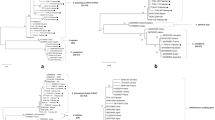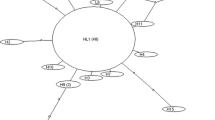Abstract
Cystic echinococcosis is a widespread zoonotic parasitic disease especially in Tunisia which is one of the most endemic countries in the Mediterranean area. The etiological agent, Echinococcus granulosus sensu lato, implies dogs and other canids as definitive hosts and different herbivore species as intermediate hosts. Human contamination occurs during the consumption of parasite eggs passed in the environment through canid feces. Hydatid cysts coming from a child operated for multiple echinococcosis were collected and analyzed in order to genotype and to obtain some epidemiological molecular information. Three targets, ribosomal DNA ITS1 fragment, NADH dehydrogenase subunit 1 (nad1), and mitochondrial cytochrome c oxydase subunit 1 (CO1) genes, were amplified and analyzed by RFLP and sequencing approach. This study presents the first worldwide report in human of a simultaneous infection with Echinococcus granulosus sensu stricto (genotype G1) and Echinococcus canadensis (genotype G6) species. This is also the first report of the presence of E. canadensis in the Tunisian population which argues in favor of a greater importance of this species in human infestation in Tunisia than previously believed.


Similar content being viewed by others
References
Adanir R, Tasci F (2013) Prevalence of helminth eggs in raw vegetables consumed in Burdur, Turkey. Food Control 31:482–484
Alvarez Rojas CA, Romig T, Lightowlers MW (2014) Echinococcus granulosus sensu lato genotypes infecting humans–review of current knowledge. Int J Parasitol 44:9–18
Ben Brahim M, Nouri A, Ksia A, El Ezzi O, Krichene I, Mekki M, Belghith M (2008) Management of multiple echinococcosis in childhood with albendazole and surgery. J Pediatr Surg 43:2024–2030
Boufana B, Lahmar S, Rebaï W, Ben Safta Z, Jebabli L, Ammar A, Kachti M, Aouadi S, Craig PS (2014) Genetic variability and haplotypes of Echinococcus isolates from Tunisia. T Roy Soc Trop Med H 108:706–714
Brunetti E, Kern P, Vuitton DA (2010) Writing panel for the WHO-IWGE. Expert consensus for the diagnosis and treatment of cystic and alveolar echinococcosis in humans. Acta Trop 114:1–16
Chaabane R, Oudni-M’rad M, Cabaret J, M’rad S, Mezhoud H, Babba H (2015) Infection of dogs with Echinococcus granulosus: causes and consequences in an hyperendemic area. Parasite Vector 8:231. doi:10.1186/s13071-015-0832-3
Chahed MK, Bellali H, Touinsi H, Cherif R, Ben Safta Z, Essoussi M, Kilani T (2010) Distribution of surgical hydatidosis in Tunisia, results of 2001–2005 study and trends between 1977 and 2005. Arch Inst Pasteur Tunis 87:43–52
Eckert TJ, Deplazes P (2004) Biological, epidemiological, and clinical aspect of Echinococcus, a zoonosis of increasing concern. Clin Microbiol Res 17:107–135
Gasser RB, Zhu X, Mc Manus DP (1998) Dideoxy fingerprinting: application to the genotyping of Echinococcus. Int J Parasitol 28:1755–1779
Ghedira Besbes L, Haddad S, Ben Meriem C, Hammami S, Nouri A, Gueddiche MN (2010) Giant hydatid lung cysts: about two paediatric cases. Resp Med 3:174–178
Hizem A, M’rad S, Oudni-M’rad M, Mestiri S, Hammedi F, Mezhoud H, Zakhama A, Mokni M, Babba H (2015) Molecular genotyping of Echinococcus granulosus using formalin-fixed paraffin-embedded preparations from human isolates in unusual tissue sites. J Helminthol. doi:10.1017/S0022149X15000516
Hüttner M, Nakao M, Torsten W, Siefert L, Boomker JDF, Dinkel A, Sako Y, Mackenstedt U, Romig T, Ito A (2008) Genetic characterization and phylogenetic position of Echinococcus felidis (Cestoda: Taeniidae) from the African lion. Int J Parasitol 8:861–868
Hüttner M, Siefert L, Mackenstedt U, Romig T (2009) A survey of Echinococcus species in wild carnivores and livestock in East Africa. Int J Parasitol 39:1269–1276
Kapoor SK, Kataria H, Patra SR, Bharadwaj M, Vijay V, Kapoor SS (2013) Multi-organ hydatidosis with extensive involvement of the hemi-pelvis and ipsilateral femur. Parasitol Int 62:82–85
Lahmar S, Debbek H, Zhang LH, McManus DP, Souissi A, Chelly S, Torgerson PR (2004) Transmission dynamics of the Echinococcus granulosus sheep-dog strain (G1genotytpe) in camels in Tunisia. Vet Parasitol 121:151–156
Limaiem F, Bellil S, Bellil K, Chelly I, Mekni A, Khaldi M, Haouet S, Zitouna M, Kchir N (2010) Primary hydatidosis of the central nervous system: a retrospective study of 39 Tunisian cases. Clin Neurol Neurosurg 112:23–28
Lymbery AJ, Thompson RCA (1989) Genetic differences between cysts of Echinococcus granulosus from the same host. Int J Parasitol 19:961–964
M’rad S, Filisetti D, Oudni M, Mekki M, Belguith M, Nouri A, Sayadi T, Lahmar S, Candolfi E, Azaiez R, Mezhoud H, Babba H (2005) Molecular evidence of ovine (G1) and camel (G6) strains of Echinococcus granulosus in Tunisia and putative role of cattle in human contamination. Vet Parasitol 12:267–272
M’rad S, Oudni-M’rad M, Filisetti D, Mekki M, Nouri A, Sayadi T, Candolfi E, Azaiez R, Mezhoud H, Babba H (2010) Molecular identification of Echincoccus granulosus in Tunisia: first record of the buffalo strain (G3) in human and bovine in the country. Open Vet Sci J 4:20–23
M’rad S, Oudni-M’rad M, Boubaker G, Bouazzi L, Gorcii M, Nouri A, Mezhoud H, Babba H (2012) Retrospective study of the distribution and the fertility of hydatid cysts in the child in Tunisia. Path Biol 60:166–169
Majorowski M, Carabin H, Kilani M, Bensalah A (2005) Echinococcosis in Tunisia: a cost analysis. T Roy Soc Trop Med H 99:268–278
McManus DP (2013) Current status of the genetics and molecular taxonomy of Echinococcus species. Parasitology 140:1–7
Nakao M, McManus DP, Schantz PM, Craig PS, Ito A (2007) A molecular phylogeny of the genus Echinococcus inferred from complete mitochondrial genomes. Parasitology 134:713–722
Nakao M, Yanagida T, Okamoto M, Knapp J, Nkouawa A, Sako Y, Ito A (2010) State-of-the-art Echinococcus and Taenia: phylogenetic taxonomy of human-pathogenic tapeworms and its application to molecular diagnosis. Infect Genet Evol 10:444–452
Sambrook J, Fritsch EF, Maniatis T (1989) Molecular cloning. A laboratory manual. Cold Spring Harbor, New York
Schneider R, Gollackner B, Schindl M, Tucek G, Auer H (2010) Echinococcus canadensis G7 (pig strain): an underestimated cause of cystic echinococcosis in Austria. Am J Trop Med Hyg 82:871–874
Umhang G, Richomme C, Boucher JM, Hormaz V, Boué F (2013) Prevalence survey and first molecular characterization of Echinococcus granulosus in France. Parasitol Res 112:1809–1812
Umhang G, Chihai O, Boué F (2014) Molecular characterization of Echinococcus granulosus in a hyperendemic European focus, the Republic of Moldova. Parasitol Res 113:4371–4376
Zhang Y, Bart JM, Giraudoux P, Craig P, Vuitton D, Wen H (2006) Morphological and molecular characteristics of Echinococcus multilocularis and Echinococcus granulosus mixed infection in a dog from Xinjiang, China. Vet Parasitol 139:244–248
Acknowledgments
This study was supported by the Tunisian Ministry of Higher Education and Scientific Research.
The authors are grateful to Gérald Umhang, (ANSES, National Reference Laboratory for Echinococcus spp., Nancy, France), for critically reading the manuscript. The authors also wish to thank Myriam Hizem-Zaddem for his assistance with the linguistic part of this paper.
Author information
Authors and Affiliations
Corresponding author
Ethics declarations
Conflict of interest
The authors declare that they have no competing interests.
Rights and permissions
About this article
Cite this article
Oudni-M’rad, M., M’rad, S., Ksia, A. et al. First molecular evidence of the simultaneous human infection with two species of Echinococcus granulosus sensu lato: Echinococcus granulosus sensu stricto and Echinococcus canadensis . Parasitol Res 115, 1065–1069 (2016). https://doi.org/10.1007/s00436-015-4836-x
Received:
Accepted:
Published:
Issue Date:
DOI: https://doi.org/10.1007/s00436-015-4836-x




